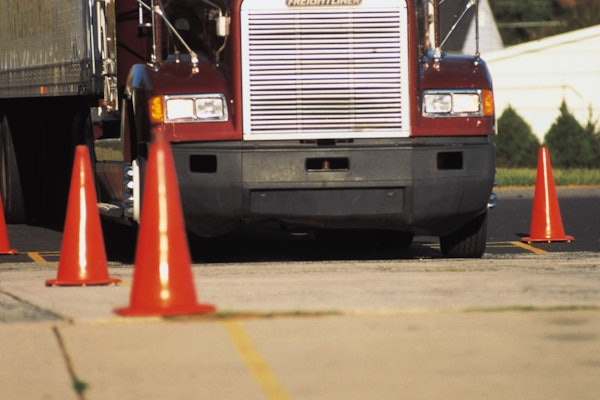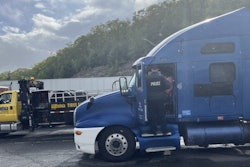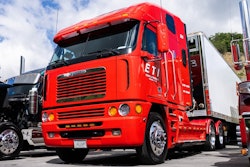I was sitting in the Consolidated Moon Base Terminal, near the Sea of Tranquility, the original Apollo moon-landing site, waiting for a driver to take me on a ride-along. I was here because my employer has always insisted that its writers have experience in trucking. The fact that my great-grandfather was a trucker in the latter half of the 20th century, and I had read his journals, did not carry any weight with my editor. There is no substitute for experience, I was told. Trucking is very different today. I was looking forward to the ride because my story idea was to compare the eras and show the contrast of 100 years.
A big man wearing a light blue jumpsuit and a cowboy hat strolled over and stuck his hand out.
“You the writer needin’ a ride?” he asked. When I answered, he handed me the duffel bag he was carrying. “I’m Harley,” he said. “You might want to change into these, you’ll be more comfortable. There’s a locker room over there. Then we’ll go do the walk around.”
We donned space suits and walked out into a huge open building with a metal floor. Too big to justify life support, it did have a pseudo-gravity of some kind. The staging bay was impressive, but not as eye-catching as Harley’s rig. From the proud Peterbilt logo on the scoop, to the polished titanium photon exhaust tubes, she was a beauty. The cockpit and living quarters of the power unit took up the first 15 feet, then tapered up to the massive 20-by-20-by-40 foot engine room, housing the Cat/Westinghouse Light Drive. Great-grandpa Bill would’ve asked the horsepower rating, but power is rated as thrust these days. Bill would have missed the tires, too, because this truck sat on an anti-grav cushion with no fifth wheel. The power unit latched directly onto the cargo unit – there are few tight turns in space. Harley explained that the standard cargo units were 40-by-40-by-150 feet long and were self-contained, with gravity and life-support, so they could accommodate different kinds of freight. We walked around the rig while Harley checked for loose fittings and peered into the access hatches. Satisfied with his inspection, we climbed through the airlock and into the cab.

The sleeper looked like a living room, with a sofa, complete audio/video entertainment center, kitchenette, plenty of storage and two bunks. “The bathroom’s in there,” he pointed, “but the shower’s on the blink. I wrote it up. We only run out to Pluto and back, so it’s no big deal. Stow your gear in the cabinet and we’ll head out.” He led me through a small door to the cockpit and we buckled up.
Harley placed his hand on a palm reader and waited a few seconds for two green lights to come on. “This here’s my log book,” he said. “The green light means I’m identified and have hours to run. The other light is a mini-physical. The engine won’t start without both green lights.” He slipped on a headset and flipped a few switches. A low hum and faint vibration ran through the cabin. He clicked on his mic. “Dispatch, this is Phantom 309, and we’re ready to roll.”
“Copy that, Phantom 309, RTR, be careful out there,” came the reply.
That call sign jiggled a dim memory from Billy’s journals, and I asked Harley about it.
“An old song from Red Sovine,” he answered. “I have a great collection of antique trucking songs, from Dave Dudley to Willie Nelson. Ever hear of them?”
“I think so,” I said. “I have some old journals from my great-grandpa who was a trucker a hundred years ago. I’m sure he mentioned them.”
Harley eased the throttle forward a notch and we coasted out of the building. He shut off the anti-grav, and as we lifted into the blackness of space, I heard him softly singing something like, “On the Road Again.”
“Lemme give you a little background so you’ll know what we’re doin’,” Harley said. “This is basically just a shuttle run ’cause it’s only 3.5 billion miles out to Pluto. At light speed, it’ll only take a little over five hours to get to the Star Mart Distribution Center, we’ll drop and hook and come right back. The big boys, the Star Trucks, don’t like to come in this close and try to maneuver around the planets to make the pick-ups. The locals make the pick-ups, and we shuttle the full cargo units out to the DC.
“As you know, our solar system is basically flat, like a dinner plate, and this plate is filled with nine planets, maybe 50 satellites, an asteroid belt and an untold number of comets running about. To avoid all this, we’ll shoot up a 30-degree arc and come out on the other side of Pluto’s orbit to Star Mart. The DC has a stationary fix, so it’s easy to find.”
Harley eased the throttle fully forward, and the rig became quiet. The visible stars no longer twinkled, just bright pinholes in the fabric of space.
“This is the boring part, nothing much to see,” Harley said. “Why don’t you catch a nap, and I’ll wake you when we get close.”
“Sounds good to me,” I said. It took a few minutes to figure out the bunk’s cargo net before I fell asleep.
Harley awakened me as we approached the Star Mart DC. It was a sight to see, a shining jewel that hung in the sky. Actually, it resembled a giant wagon wheel, brightly lit around its rim and the central hub. A closer look revealed the rim lights were colored in sections, half the circumference being red, one-quarter green and one-quarter white.
“We’ll be given a door assignment in the red section,” Harley said. “The red’s for incoming freight, the white for outgoing. See, there’s a Star Truck in the middle of the white sector. The green’s for station supply. Over 800 people live here permanently and they have to be supplied, especially with fuel. They’re so far from our sun that they can’t get much energy. They use fusion generators, and they always have a couple of tankers.”
My eyes were glued to the Star Truck. It was enormous! Too large to enter the rim, it was backed up against it. Its cargo lock must have been a quarter mile wide. The rig itself had to be a mile long, but it looked almost fragile. I knew it would never feel the pull of gravity. I asked Harley if we could take a tour.
“Your best bet there is to arrange a ride-along,” he said. “Maybe we’ll meet the drivers in the lounge. They usually run two three-man teams and are gone from three weeks to three months. Their cab is pretty much like mine, but the sleepers are much bigger. About half of that ship is cargo space, and it can hold fifty cargo units. The Westinghouse Star Drive engine is so fast it is unable to go slow enough to do our run. They push it away from the dock with a pony engine, then generate their warp field and just disappear!”
During this talk, Harley backed us to a dock door, and the nav computer backed us inside. Billy would have loved this. We donned our suits, left the rig and boarded a shuttle to the lounge. Through the helmet radio Harley continued the lecture.
“The cargo units are pushed onto that conveyor,” he said. “It runs around the rim, and it’ll take our trailer to the Star Truck, bring us a loaded one back and hook it up. By the time we grab a bite to eat, we’ll be ready for the trip home.”
When we entered the lounge, Harley spotted someone he knew. He was an older man with a full, white beard, which must have interfered with a helmet.
“Noah, you old son,” Harley said. “His name’s not really Noah, but we call him that because he pulls an ark,” Harley said. “This here’s William, my ride-along.” Noah nodded and moved over to make room in the booth.
“What’s an ark?” I asked.
“An ark’s a cargo unit for carrying animals,” Noah explained. “It’s self-contained and has living quarters for a vet and two helpers. After a new planet is terraformed and the colonists arrive, they usually call for their critters. We give them an ark full of whatever they need for their ecosystem – animals, birds and bugs.”
I listened with half an ear while Noah and Harley caught up and swapped lies. The food was real, and good. I guess if you’re the freight hub for the solar system you have access to everything, and I was willing to wager that one of Noah’s cows had wandered into the kitchen at just the right time. Sure beat soyburgers.
Back in the truck, we were just clearing the dock airlock when a brilliant flash of light announced the departure of another rig in front of us.
“That’s ole Noah,” said Harley. “Ark-haulers always gotta be in front.”
Harley pushed the throttle all the way up and fell in behind the pulsing light ahead of us. I was becoming mesmerized by Noah’s exhaust when it suddenly disappeared, causing Harley to immediately throttle back and steer to the right.
“Oh-oh,” Harley said, “that’s not good.”
“Mayday, mayday!” Noah’s voice filled our cab. “I’ve been holed, through the windshield, engines and life support gone! You copy, Phantom?”
“We copy, Noah, we’re right behind you. Suit up. We’ll be there as soon as we figure out where you are.” Harley flipped a few switches and pointed to a dot on the scanner. “There he is, just where I figured, still moving near light speed, so whatever he hit wasn’t very big.”
Harley jammed the throttle to the max-stop. “Thank God he slowed a touch or we’d never catch him. He’d just started the ark. If we don’t catch him, he’ll sail off into deep space with only his suit of life support, which is only good for about five hours.”
Harley’s face was grim as he kept pushing the throttle against the unrelenting stop. Noah’s dot was getting larger in the scanner. So we were catching up.
“Shouldn’t we call for help?” I asked.
“It’d take hours for someone else to get here, let alone find us,” Harley said. “It’s gonna take us a while to catch up, and we’re right behind him. There’s all kinda things floating around out here which our shields mostly deal with. But energy fields fluctuate, and at light speed, there are gaps when something can get through. If Noah had hit something the size of a marble, it wouldn’t have slowed him down, so in a way he was lucky he hit something bigger.”
Four hours passed until Noah’s dot resolved into something recognizable. Noah didn’t have much time left.
“Good!” Harley observed. “He’s not spinning, just doing a slow roll on the long axis, like a chicken on a spit. It’ll be easy to match up.”
Harley’s plan was to match speed and roll alongside Noah’s rig, then do a space walk to get him. With practiced ease, Harley completed the difficult maneuvers, and we parked alongside the crippled truck. A shiver passed through me when I saw the basketball-size hole in the engine compartment. Harley suited up, entered the airlock, then floated lazily toward the ark on his tether. He had set the radio so I could hear their suit communicators.
“‘Bout time you got here,” Noah said. “I was fixin’ to take a nap.”
“Yeah,” Harley replied, “a real long nap.”
I was amazed! One man was a few breaths from death and the other had performed a feat not unlike the proverbial “needle in a haystack,” and both of them sounded like they were back in the coffee shop all the way back to the moon base.
“You know, Noah, savin’ your sorry butt has made me late for supper. Momma’s gonna think I got a girlfriend on Star Mart.”
“Quit complainin’,” Noah replied, “and think of all the extra miles you’ll get paid.”
“They’ll probably charge me for them,” Harley sniffed. “Out-of-route. But you’ll get paid for breakdown time.”
“So, I’ll buy you lunch next time.”
They left me standing in the shuttle waiting room, still jawin’ at each other, and I could only shake my head at their retreating backs. I thought back to great-Grandpa Billy’s journals, and decided maybe I’d change my original idea. Yes, the speeds were greater, the miles longer, the equipment different – but all in all, trucking hasn’t really changed that much.
About the author
Steven Beres grew up in Southern California and started his trucking career in the U.S. Army in 1968, including a tour in Vietnam where he hauled everything from plastic spoons to napalm bombs.
He has driven OTR for the last 11 years, most recently pulling milk for MTS out of Portales, N.M. Living only 89 miles from Roswell sparked his interest in UFOs and sci-fi, which led to his story, “Ride-Along.”
Beres says “long hours in the cab give a person time to think and I’ve written lots of stories in my head. Now it’s time to put them on paper and I thank Truckers News for that opportunity.
“May all your roads be dry and all the scales closed.”









